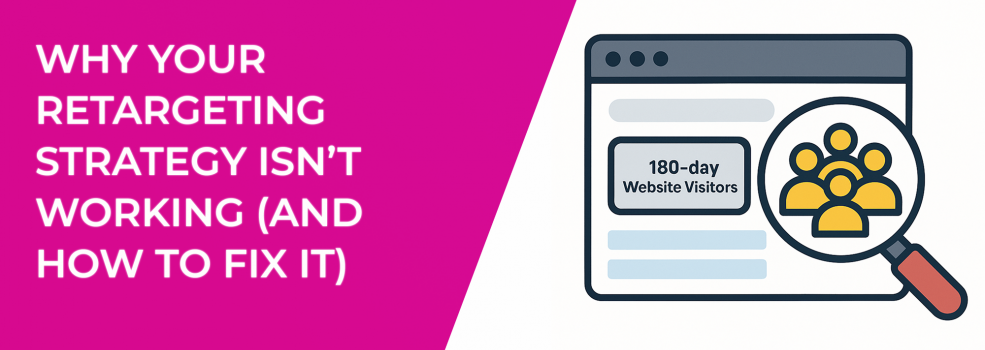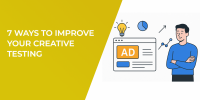Retargeting should be the easy money in your funnel. Someone has already clicked your ad, visited your site, maybe even added a product to their cart. Yet your numbers tell another story: high frequency, flat click-throughs, and cost-per-purchase inching ever higher. If that sounds familiar, keep reading — you are about to learn why most campaigns stall and exactly how to turn yours around.
Retargeting fails for two big reasons: you are talking to the wrong people or saying the wrong things to the right people. Everything else — audience sizes, placements, bid caps — rolls up to those two points. Below you will find the seven most common traps that sink Facebook ad targeting options and a clear roadmap out of each one.
1. You Are Targeting the Wrong People
Before any ad shows, Meta decides who will see it. If your audience contains every site visitor from the last 180 days, quality tanks. Relevance dips, cost rises, and you end up buying impressions from people who forgot they ever clicked your link. Narrow, intent-based segments always beat a bloated catch-all pool.
Smart audience fixes
-
Break visitors into 3-, 14-, and 30-day windows to match intent.
-
Separate custom audience pools for product viewers, cart abandoners, and past purchasers.
-
Seed a 1% lookalike audience from recent buyers and exclude that seed from your core retargeting sets.
-
Layer Facebook interest targeting to rescue promising prospects who bounced early.
Smaller, intent-based segments always outperform a single bloated list.
Still mapping out your first segments? Check out our primer on Facebook Ad Targeting 101: How to Reach the Right Audience for step-by-step examples you can copy today. Not sure when to use a seed list or a mirror audience? The article Custom vs Lookalike Audiences: What Works Best for Facebook Campaigns? shows the trade-offs with real ROAS data.
2. Your Pixel Data Is Incomplete or Wrong
No pixel events mean no optimization. Many brands install the base pixel but forget to pass Purchase, Add-To-Cart, or value parameters. Clean, complete data powers Meta’s entire delivery system.
Pixel health checklist
-
Verify every standard event with the Facebook Pixel Helper extension.
-
Attach value, currency, and content_type to each fire so campaign budget optimization can rank users correctly.
-
Add the Conversions API for server-side redundancy and stronger signal amid browser privacy blocks.
For a deeper dive into pixel-based segmentation, see Unlock Laser-Targeted Results with Meta Pixel Audience Segmentation.
3. Your Creative Has Gone Stale
If you have ever watched performance nosedive overnight, our guide to spotting Ad Fatigue on Facebook: How to Spot It Early and Fix It Fast will feel painfully familiar. Frequency climbs, click-through drops, and the offer that once crushed suddenly fizzles. Audiences burn out faster than marketers update ads.
Rotating creative every 10–14 days keeps engagement high and fatigue low.
Creative refresh tactics
-
Cap frequency near three impressions per person over seven days.
-
Rotate new hooks every 10–14 days: testimonials, FAQs, limited-time bonuses, or user-generated videos.
-
Turn on dynamic product ads so Meta automatically pulls the most relevant SKU for each shopper.
4. Your Budget Mix Is Upside-Down
Pouring most of your spend into retargeting feels safe, but it slowly starves your funnel of new people to remarket. Prospecting must feed retargeting or both will fail.
Budget re-balancing tips
-
Allocate roughly 70% to prospecting CBO, 20% to retargeting with its own ad-set budgets, and 10% to experimental tests.
-
When scaling a winning set, raise spend by no more than 20% every two days to hold the learning phase.
-
Try advantage campaign budget on evergreen campaigns to let Meta shift dollars to the best-performing set in real time.
When you are finally ready to scale spend, follow the principles in The Science of Scaling Facebook Ads Without Killing Performance.
5. You Are Optimizing for the Wrong Event
Optimizing a retargeting ad set for Add-To-Cart may look cheaper on the dashboard, but it teaches the algorithm to chase cart fillers, not buyers. The event you choose shapes the leads you get.
Event-level optimization guide
-
Optimize for Purchase whenever you can hit 50 conversions weekly.
-
If volume is lower, step back to Initiate Checkout until data improves.
-
Use a 1-Day Click and 1-Day View attribution window for hot audiences so Meta focuses on shoppers who are ready to buy now.
Mastering Meta’s learning phase is half the battle; this walkthrough, How to Finish the Facebook Learning Phase Quickly, shows how to hit stability in days, not weeks.
6. Your Landing Experience Breaks the Promise
Ad copy says “Free shipping today,” landing page barely mentions it. Result: high bounce, lost sale. Ad-to-page consistency is a silent ROAS killer.
Message match between ad and landing page helps reduce bounce rate and boost conversions.
Rapid landing-page tune-ups
-
Mirror ad headline and hero text on the first screen of your page.
-
Compress images, enable lazy-loading, and keep load time under two seconds.
-
Run a quick heat-map session to spot scroll drop-offs and patch the friction.
7. You Ignore New Meta Automation Features
Meta releases new tools monthly. Early adopters reap lower CPMs and stronger delivery. Staying current keeps you ahead of platform shifts instead of chasing them.
Features to test this month
-
Advantage detailed targeting blends broad reach with algorithmic learning to uncover hidden buyers.
-
Advantage+ audience lets machine learning expand beyond your set interests while still respecting exclusions.
-
Retarget with a 14-day engagers pool alongside these broad tools so you stay present while Meta finds fresh lookalikes.
Want to stay ahead of next year’s changes? Bookmark Facebook Ads Targeting Updates: How to Adapt in 2025 so you are ready before the algorithm shifts again.
The 30-Day Rescue Blueprint
-
Audit all pixel events and add Conversions API.
-
Re-segment Facebook ads keywords by funnel stage and exclude recent purchasers.
-
Distribute budget 70 / 20 / 10 across prospecting, retargeting, and testing.
-
Refresh creative every two weeks, leaning on dynamic product ads for catalog items.
-
Optimize for Purchase with a tight attribution window.
-
Enable advantage campaign budget or campaign budget optimization on evergreen campaigns.
-
Watch ROAS, frequency, and CPM daily, pivot fast.
Follow these steps and within one month you will notice steadier costs, healthier return on ad spend, and a retargeting engine that finally pulls its weight.

